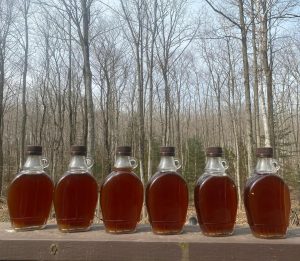Ann Hui of the Globe and Mail reports that a few years ago, federal food inspectors were walking around the warehouses of the Ontario Food Terminal in Toronto – the nerve centre where much of the province’s fresh produce is bought, re-packaged and sold – when they noticed something unusual.
 In the “farmer’s market” area, where only Ontario-grown produce is meant to be sold, the inspectors saw large cartons of greenhouse peppers with conflicting labels. The outside of the boxes had “Product of Canada” stickers, next to visible signs of damage on the cardboard – bits of paper and glue, as if another sticker had been peeled off. And stickers on the inside of the box read “Product of Mexico.”
In the “farmer’s market” area, where only Ontario-grown produce is meant to be sold, the inspectors saw large cartons of greenhouse peppers with conflicting labels. The outside of the boxes had “Product of Canada” stickers, next to visible signs of damage on the cardboard – bits of paper and glue, as if another sticker had been peeled off. And stickers on the inside of the box read “Product of Mexico.”
That discovery in January, 2012, led the Canadian Food Inspection Agency into a three-year investigation of the company behind the peppers, Mucci Farms – the largest such probe in the agency’s history.
After executing three search warrants at the company’s headquarters in Kingsville, Ont., and poring over its computer records and internal e-mails, CFIA investigators pieced together evidence that, between late 2011 and early 2013, Mucci had been selling imported products as Canadian – putting hundreds of shipments of mislabelled produce worth more than $1.4-million onto Ontario grocery store shelves.
In one e-mail described in a court document and obtained by The Globe and Mail, one of the company’s directors, Danny Mucci, responded to a message from an employee about a shortage of Canadian mini cucumbers by telling the worker: “you know what to do to fill…it’s only 30 cases.”
Mucci International Marketing Inc., Mucci Pac Ltd. and two of its directors (Mr. Mucci and Joseph Spano) pleaded guilty in June of this year to eight regulatory offences – including one count against the company for selling food in a “false, misleading or deceptive” manner – and were fined $1.5-million.
Mucci’s lawyer, Patrick Ducharme, said in an interview that the mislabelling was not intentional, and that, given the volume of Mucci’s 1,200-employee operation, the transactions made up “a very small part of what they do.” He also emphasized that they pleaded guilty to regulatory offences, not criminal ones. Criminal charges against Mucci International and Mucci Pac and the two directors of defrauding the public, and defrauding Costco, Loblaw and Sobeys – to whom Mucci sold the produce – were withdrawn.
The case sent shockwaves through the country’s agriculture industry, and the Ontario Greenhouse Vegetable Growers called it a “unique” precedent. “My hope is that it’s an isolated case,” the marketing board’s manager, Rick Seguin, said in an interview.
If the best you can do is hope, then OGVG is in for trouble.
I helped – or did – set up the OGVG on-farm food safety program way back when OFFS wasn’t cool – about 1998.
We got a couple of papers out of it, along with reams of anectodes and observations and every time I’ve blogged about them, the new types at OGVG have threatened to sue (that’s a pic, upper left, of my 14-monty-old grandon #2, Emerson, instead of tomatoes; sue that).
I’m used to that.
And since I’m just a lowly former academic, the legal types tell me, you can’t afford it.
So I’ll let CFIA and the Globe run with it.
 I had nothing to do with it.
I had nothing to do with it.
Can only sit back and sigh.
For years, experts have been sounding the alarm on mislabelling and food fraud. Increasingly, they say, criminal organizations around the world are targeting the food system, intercepting supply chains and deliberately misrepresenting or adulterating products – and costing the food industry between $10-billion and $15-billion (U.S.) each year, according to the U.S.-based Grocery Manufacturers Association.
And, according to conversations with experts in the Canadian food industry, scientists and regulators, the problem is widespread within our own borders.
But even the CFIA does not seem to know just how widespread it is. Individual cases provide an incomplete picture. And the 74 cases of non-compliance with labelling laws from the past year published on the CFIA website – a number the agency say has held steady over the past five years – present only a portion of incidents where the agency has found companies breaking the rules. It includes only the cases in which the products were actually seized and detained or disposed of, but also includes technical infractions, like language or font size on packaging.
When asked how prevalent the problem is in Canada, the agency cited U.S. data that show fraud affects about 10 per cent of all food products globally. It also acknowledged it has not yet conducted a widespread survey of its own to understand its full impact within Canada.
In his years as a lawyer representing companies in intellectual property and anti-counterfeiting cases in Canada, Lorne Lipkus has seen cases of food fraud ranging from counterfeit basmati rice (knockoffs of a high-end brand) to fake ginseng.
“You’d think: ‘How expensive is it to grow a bag of rice,’” he said. “But if someone’s making something and making a profit out of it, somebody’s counterfeiting it. … Everything we do in Canada is reactive. We have very poor laws, compared to other countries. And we haven’t had any government involved in the longest time – I’m talking decades – willing to provide the resources to law enforcement to do anything about counterfeiting.”
In EU countries, border officials have the authority to seize and destroy goods they believe are counterfeit. In Canada, customs officials can detain a product, but it is then incumbent on the complainant to undertake court action and to pay for the goods to remain in detention until the case is heard – which can cost in the tens of thousands of dollars.
Most alarming, he said, is that the scope of the problem is not understood because no agency is specifically looking for fraud.
On the issue of mislabelling, experts also point to policy initiatives abroad – such as a U.S. proposal to require companies to have food fraud prevention programs – as evidence others seem to take the issue more seriously.
Although the CFIA has not conducted a full survey of the issue in Canada, James Crawford, acting associate vice-president of operations with the federal agency, said CFIA receives about 40 complaints a year about possible food misrepresentation.
In an interview, Mr. Crawford said the agency takes food fraud seriously. He also said Canadians are generally safe from adulterated food – pointing to a Conference Board of Canada study in 2014 that ranked the country’s food system as the safest of 17 OECD countries surveyed.
Stop.
That was a bullshit survey with criteria based on nothing.
On fraud, he said, “we’re proactive and reactive.”
He said CFIA staff conduct regular inspections of imported and domestic food – including daily inspections at meat processing plants. Still, he was not able to say what percentage of products undergoes such scrutiny for labelling.
“We can’t inspect every … import or domestically produced food in Canada. It’s impossible. That’s why we have a risk-based plan. And it allows us to focus on where we think the high risks are.” Some of the things the agency takes into account in prioritizing inspections include food type and likelihood for illness, and each company’s track record of compliance.
Even countries with the most aggressive approaches faced the reality that food fraud is not easily confined by borders.
In Canada, much of the action on the issue has been industry-led. Large retailers in Canada like Loblaw or Costco have programs to safeguard against adulterations, requiring suppliers to subscribe to standardized food safety programs, and undergo annual audits.
Stop.
Audits and inspections are largely shit.
As for Mucci, it is on a three-year probation during which CFIA inspectors will have free access to its premises and computer records. Mr. Ducharme says the company is doing everything it can to ensure accuracy of its labelling, including appointing a compliance officer and reviewing all of its processes.
He believes the CFIA targeted Mucci in part to set an example. “I don’t think it’s insignificant that the place that was targeted for the big investigation was the biggest in the industry,” he said. “They know Mucci’s the biggest. The best.”
Uh-huh.
 Before the pandemic, her and her partner sold their Toronto-area house and resorted to rural Ontario where they have embraced the country life.
Before the pandemic, her and her partner sold their Toronto-area house and resorted to rural Ontario where they have embraced the country life.












